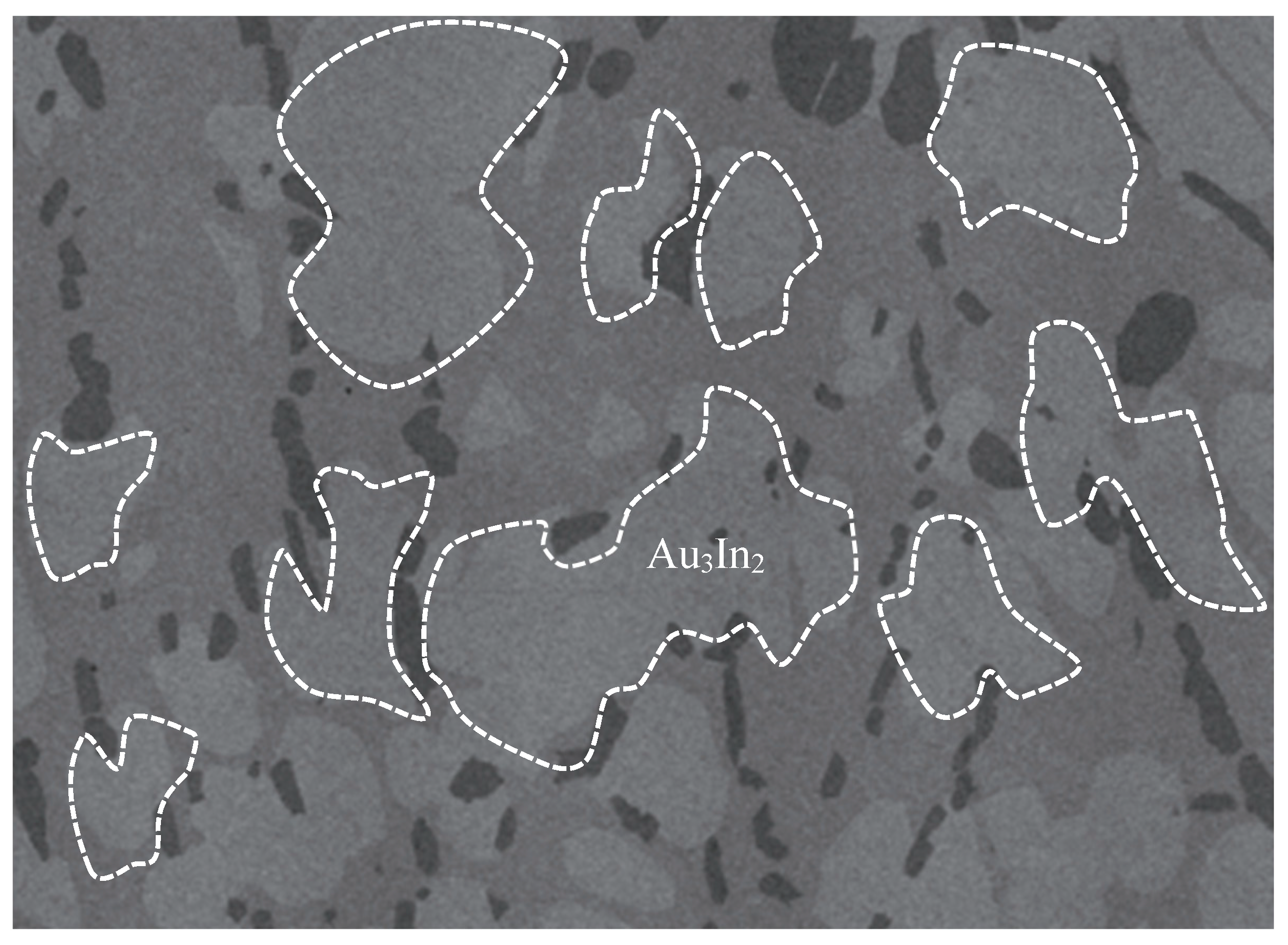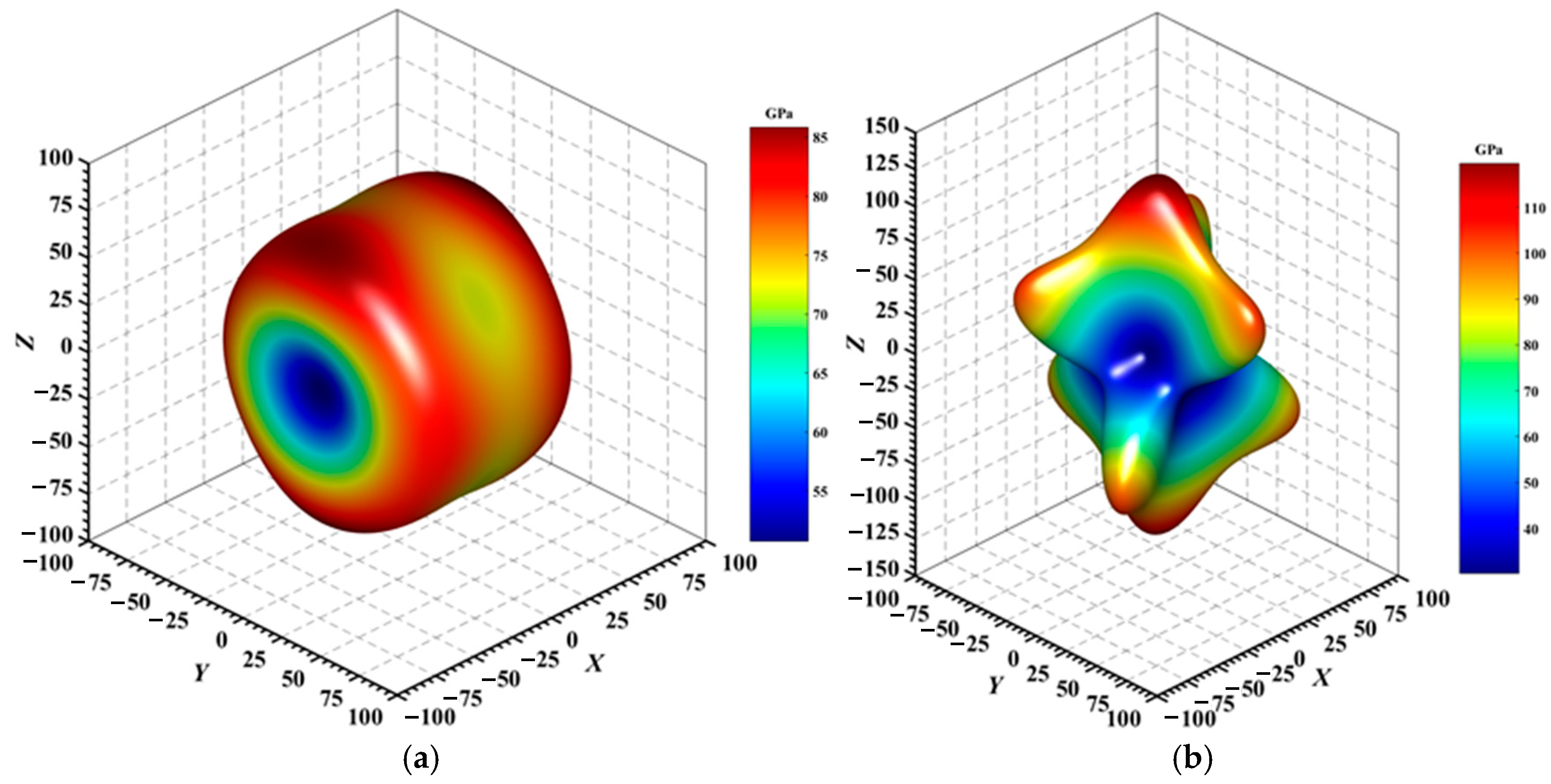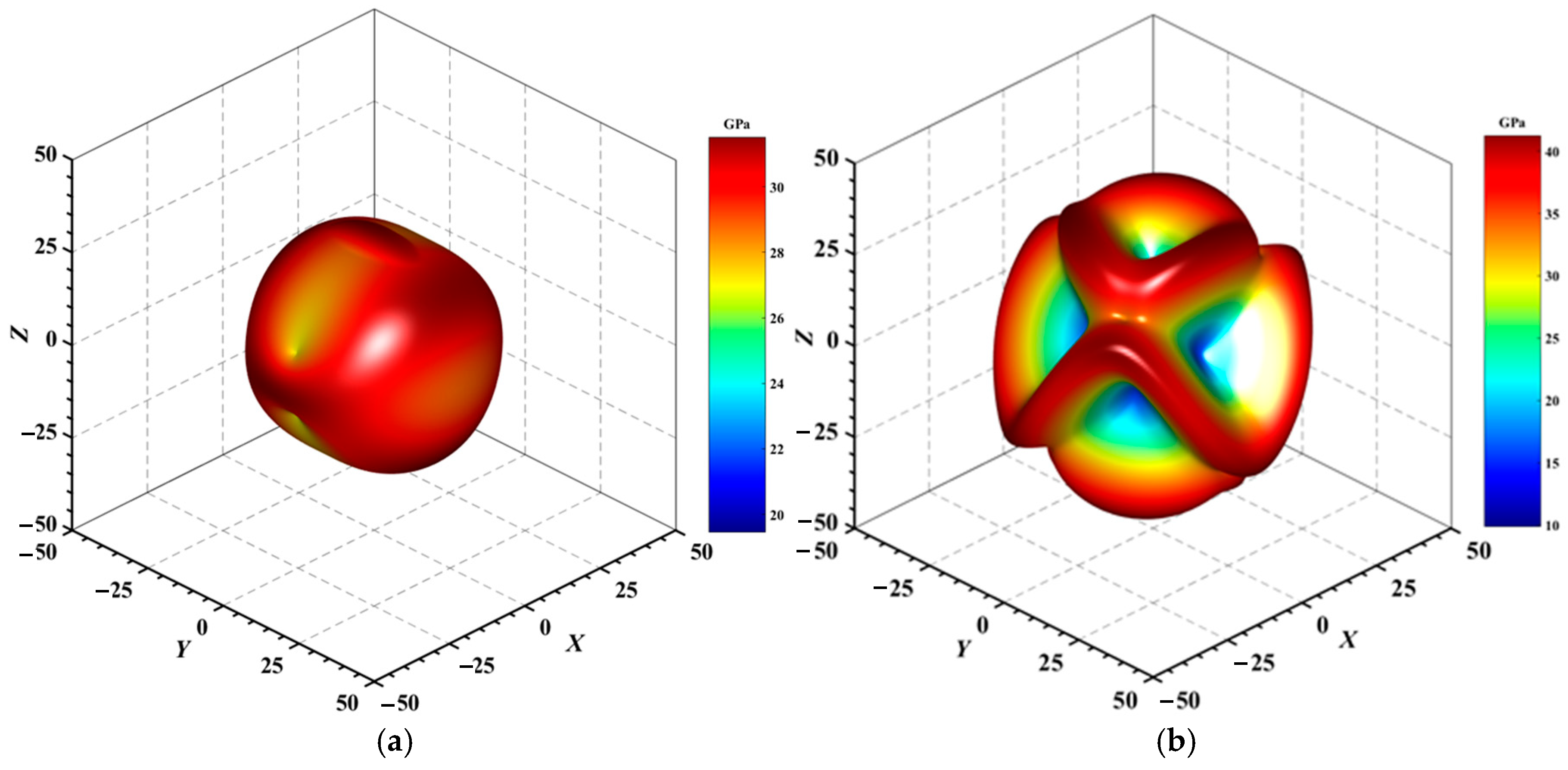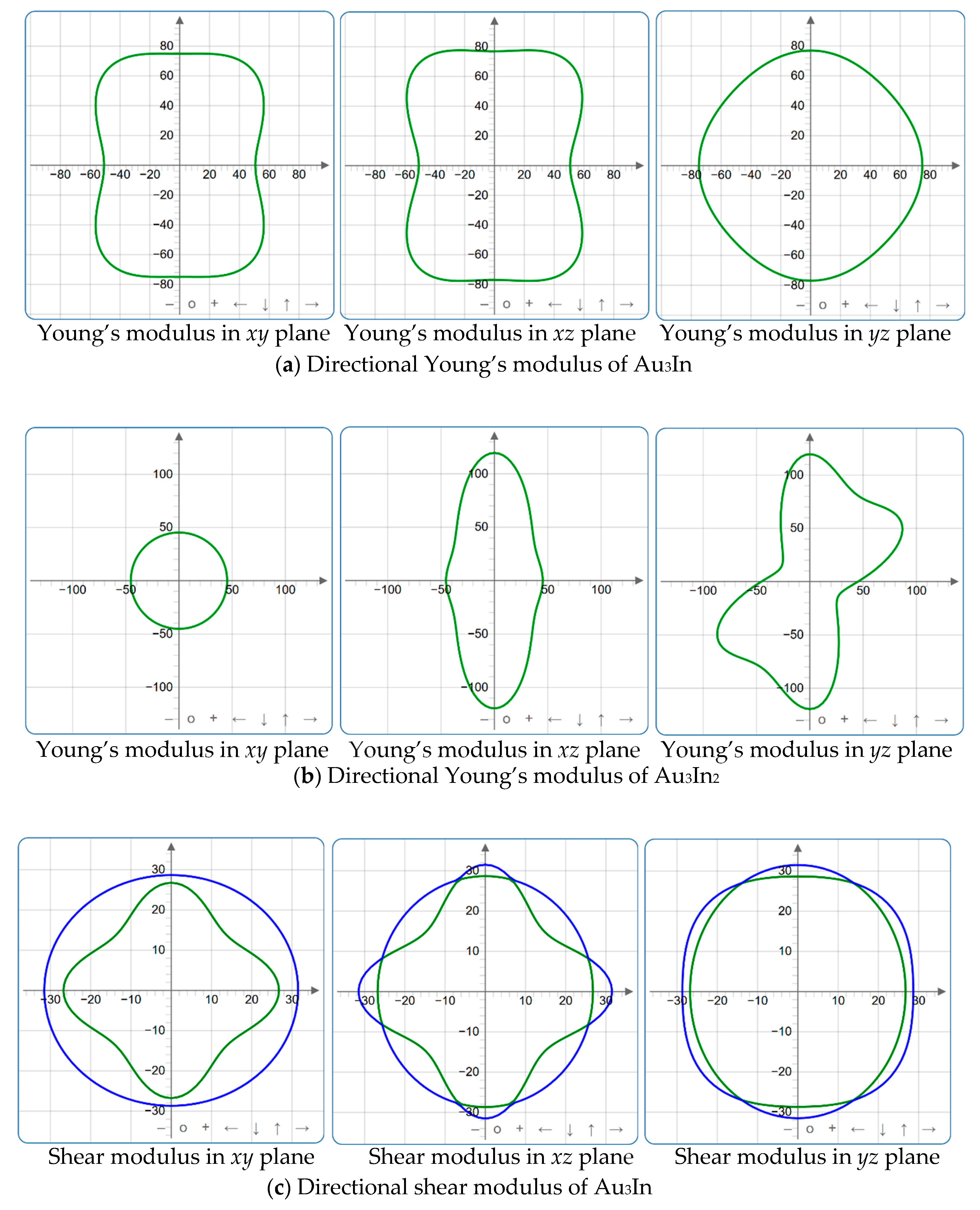DFT Study of Au3In and Au3In2 Intermetallic Compounds: Structural Stability, Fracture Toughness, Anisotropic Elasticity, and Thermophysical Properties for Advanced Applications
Abstract
:1. Introduction
2. Methods
3. Results
3.1. Structural Properties and Phase Stability
3.2. Elastic and Mechanical Properties
3.2.1. Phase Stability
3.2.2. Comparison of Elastic Constants
3.2.3. Cauchy Pressure
3.2.4. Kleinman Parameter
3.2.5. Mechanical Properties
3.3. Characterization of Elastic Anisotropic Properties
3.3.1. Anisotropy Indexes
3.3.2. Directional Mechanical Properties
3.4. Thermophysical Properties
3.4.1. Debye Temperature
3.4.2. Coefficients of Thermal Expansion
3.4.3. Melting Point
3.4.4. Heat Capacity
3.4.5. Dominant Phonon Wavelength
3.4.6. Thermal Conductivity
4. Conclusions
Author Contributions
Funding
Institutional Review Board Statement
Informed Consent Statement
Data Availability Statement
Acknowledgments
Conflicts of Interest
References
- Tolochyn, O.I.; Baglyuk, G.A.; Tolochyna, O.V. Structure and Physicomechanical Properties of the Fe3Al Intermetallic Compound Obtained by Impact Hot Compaction. Mater. Sci. 2021, 56, 499–508. [Google Scholar] [CrossRef]
- Yu, C.F.; Peng, J.W.; Hsiao, C.C.; Wang, C.H.; Lo, W.C. Development of GUI-Driven AI Deep Learning Platform for Predicting Warpage Behavior of Fan-Out Wafer-Level Packaging. Micromachines 2025, 16, 342. [Google Scholar] [CrossRef] [PubMed]
- Ma, H.; Qin, G.; Geng, P.; Ao, Z.; Chen, Y. Effect of Intermetallic Compounds on the Mechanical Property and Corrosion Behaviour of Aluminium Alloy/Steel Hybrid Fusion-Brazed Welded Structure. J. Manuf. Process. 2022, 75, 170–180. [Google Scholar] [CrossRef]
- Liu, X.; Tatsumi, H.; Jin, Z.; Chen, Z.; Nishikawa, H. Fabrication and Thermo-Mechanical Properties of Ag9In4 Intermetallic Compound. Intermetallics 2023, 162, 108028. [Google Scholar] [CrossRef]
- Li, W.; Dong, H.; Zhang, B.; Zou, S.; Mu, W.; Cai, Y. The Influence of Adjustable Ring-Mode Laser on the Formation of Intermetallic Compounds and Mechanical Properties of Ultra-Thin Al-Cu Lap Welded Joints. J. Mater. Process. Technol. 2024, 332, 118537. [Google Scholar] [CrossRef]
- Klumel, G.; Gridish, Y.; Szafranek, I.; Karni, Y. Reliable High Power Diode Lasers: Thermo-Mechanical Fatigue Aspects. Proc. SPIE High-Power Diode Laser Technol. Appl. IV 2006, 6104, 610402. [Google Scholar]
- Otnes, G.; Heurlin, M.; Graczyk, M. Strategies to Obtain Pattern Fidelity in Nanowire Growth from Large-Area Surfaces Patterned Using Nanoimprint Lithography. Nano Res. 2016, 9, 2852–2861. [Google Scholar] [CrossRef]
- Jany, B.R.; Janas, A.; Szajna, K.; Kryshtal, O.; Cempura, G.; Kruk, A.; Czyrska-Filemonowicz, A.; Krok, F. Chemically driven growth of Au rich nanostructures on AIII-BV semiconductor surfaces. Nanoscale 2020, 12, 9067–9081. [Google Scholar] [CrossRef]
- Ivey, D.G.; Jian, P. Metallurgy of Ohmic Contacts to InP. Can. Metall. Q. 1995, 34, 85–113. [Google Scholar] [CrossRef]
- Eyring, L.; Dufner, C.; Goral, J.P.; Holladay, A. High-Resolution Electron Microscopic Studies of Chemical Reactions in Thin Films. Ultramicroscopy 1985, 18, 253–274. [Google Scholar] [CrossRef]
- Goral, J.P.; Holladay, A.; Eyring, L. Time-Resolved Analysis of High-Resolution Electron Microscope Images. Ultramicroscopy 1985, 18, 275–280. [Google Scholar]
- Piotrowska, A.; Auvray, P.; Guivarc’h, A.; Pelous, G.; Henoc, P. On the Formation of Binary Compounds in the Au/InP System. J. Appl. Phys. 1981, 52, 5112–5117. [Google Scholar]
- Weizer, V.G.; Fatemi, N.S.; Korenyi-Both, A.L. Au/Zn Contacts to p-InP: Electrical and Metallurgical Characteristics and the Relationship Between Them. NASA Tech. Memo 1994, 337, 106590. [Google Scholar]
- Clausen, T.; Pedersen, A.S.; Leistiko, O. Contact Metallurgy Optimization for Ohmic Contacts to InP. Microelectron. Eng. 1991, 15, 157–160. [Google Scholar]
- Wada, O. Thermal Reaction of Gold Metallization on InP. J. Appl. Phys. 1985, 57, 1901–1909. [Google Scholar]
- Huang, W.C.; Wang, C.C. Stack-Layered Metals AuSiNi Ohmic Contact to n-InP. In Proceedings of the IEEE International Conference Nanotechnology, Shanghai, China, 15–16 May 2006; pp. 291–294. [Google Scholar]
- Cherneva, S.; Iankov, R.; Georgiev, M.; Dobrovolska, T.; Stoychev, D. Investigation of the Mechanical Properties of Electrochemically Deposited Au-In Alloy Films Using Nano-Indentation. Mater. Technol. 2016, 50, 689–693. [Google Scholar]
- Wodniecki, P.; Kulińska, A.; Wodniecka, B.; Hrynkiewicz, A.Z. Electric Field Gradients at the In Site in Au-In Compounds. Z. Naturforsch. 1998, 53a, 349–354. [Google Scholar]
- Wei, H.L.; Zhang, L.; Liu, Z.L.; Yao, K.L. Fabrication and Photoluminescence Characteristics of In2O3 Nanohillocks. Chin. Phys. B 2011, 20, 118102. [Google Scholar]
- Póczi, B.; Veresegyházy, R.; Mojzes, I.; Járóli, E.; Zsoldos, I. Thermal Behaviour of Au/InP Samples Controlled with Mass Spectrometer. Vacuum 1990, 40, 185–188. [Google Scholar]
- Vandenberg, J.M.; Temkin, H.; Hamm, R.A.; DiGiuseppe, M.A. Structural Study of Alloyed Gold Metallization Contacts on InGaAsP/InP Layers. J. Appl. Phys. 1982, 53, 7385–7390. [Google Scholar]
- Ghasemi, M.; Lidin, S.; Johansson, J. The Phase Equilibria in the Au–In–Ga Ternary System. J. Alloys Compd. 2014, 588, 474–480. [Google Scholar]
- Hohenberg, P.; Kohn, W. Inhomogeneous Electron Gas. Phys. Rev. 1964, 136, 864–871. [Google Scholar]
- Perdew, J.P.; Burke, K.; Ernzerhof, M. Generalized Gradient Approximation Made Simple. Phys. Rev. Lett. 1996, 77, 3865–3868. [Google Scholar] [PubMed]
- Perdew, J.P. Restoring the Density-Gradient Expansion for Exchange in Solids and Surfaces. Phys. Rev. Lett. 2008, 100, 136406. [Google Scholar]
- Hill, R. The Elastic Behaviour of a Crystalline Aggregate. Proc. Phys. Soc. 1952, 65, 349–350. [Google Scholar]
- Hiscocks, S.E.R.; Hume-Rothery, W. The Equilibrium Diagram of the System Gold-Indium. Proc. R. Soc. Lond. A 1964, 282, 318–330. [Google Scholar]
- Schubert, K.; Gohle, R.; Breimer, H. Zum Aufbau der Systeme Gold-Indium, Gold-Zinn, Gold-Indium-Zinn und Gold-Zinn-Antimon. Z. Metallkd. 1959, 50, 146–153. [Google Scholar]
- Burkhardt, W.; Schubert, K. Über Messingartige Phasen mit A3-Verwandter Struktur. Z. Metallkd. 1959, 50, 442–452. [Google Scholar] [CrossRef]
- Schubert, K.; Breimer, H.; Gohle, R. Einige Strukturelle Ergebnisse an Metallischen Phasen III. Naturwissenschaften 1958, 45, 360–361. [Google Scholar]
- Segall, M.D.; Lindan, P.J.D.; Probert, M.J.; Pickard, C.J.; Hasnip, P.J.; Clark, S.J.; Payne, M.C. First-Principles Simulation: Ideas, Illustrations and the CASTEP Code. J. Phys. Condens. Matter. 2002, 14, 2717–2744. [Google Scholar]
- Yong, X.; Liu, X.; Yang, M.; Zhou, X. First-Principles Calculate the Stability, Mechanical Properties and Electronic Structure of Carbide MC, M2C and M6C in M50NiL Steel. Materials 2024, 17, 3498. [Google Scholar] [CrossRef]
- Rusevich, L.L.; Brik, M.G.; Gryaznov, D.; Srivastava, A.M.; Chervyakov, I.; Zvejnieks, G.; Bocharov, D.; Kotomin, E.A. First-Principles Linear Combination of Atomic Orbitals Calculations of K2SiF6 Crystal: Structural, Electronic, Elastic, Vibrational and Dielectric Properties. Materials 2024, 17, 4865. [Google Scholar] [CrossRef] [PubMed]
- Guo, Y.; Jiang, B.; Zhang, X.; Li, S. First-Principles Study of the Structural, Mechanical, Electronic, and Thermodynamic Properties of AlCu2M (M = Ti, Cr, Zr, Sc, Hf, Mn, Pa, Lu, Pm) Ternary Intermetallic Compounds. Materials 2024, 17, 3441. [Google Scholar] [CrossRef] [PubMed]
- Vanderbilt, D. Soft Self-Consistent Pseudopotentials in a Generalized Eigenvalue Formalism. Phys. Rev. B 1990, 41, 7892–7895. [Google Scholar]
- Head, J.D.; Zerner, M.C. A Broyden-Fletcher-Goldfarb-Shanno Optimization Procedure for Molecular Geometries. Chem. Phys. Lett. 1985, 122, 264–270. [Google Scholar]
- Brillouin, L. Les Électrons dans les Métaux et le Classement des Ondes de De Broglie Correspondantes. Compt. Rendus Acad. Sci. 1930, 191, 292–294. [Google Scholar]
- Monkhorst, H.J.; Pack, J.D. Special Points for Brillouin-Zone Integrations. Phys. Rev. B 1976, 13, 5188–5192. [Google Scholar] [CrossRef]
- Chen, W.H.; Yu, C.F.; Chiang, K.N.; Cheng, H.C. First-Principles Density Functional Calculations of Physical Properties of Orthorhombic Au2Al Crystal. Intermetallics 2015, 62, 60–68. [Google Scholar] [CrossRef]
- Wang, F.; Lv, S.; Fu, C.; Zhang, C. The First-Principles Calculations on Trigonal and Hexagonal Structures of BiFeO3. Ferroelectrics 2017, 520, 177–183. [Google Scholar]
- Wallace, D.C. Thermodynamics of Crystal; Wiley: New York, NY, USA, 1972. [Google Scholar]
- Pettifor, D.G. Theoretical predictions of structure and related properties of intermetallics. Mater. Sci. Technol. 1992, 8, 345–349. [Google Scholar] [CrossRef]
- Liu, L.; Wu, X.; Wang, R.; Nie, X.; He, Y.; Zou, X. First-Principles Investigations on Structural and Elastic Properties of Orthorhombic TiAl Under Pressure. Crystals 2017, 7, 111. [Google Scholar] [CrossRef]
- Wu, Y.; Duan, Y.; Wang, X.; Peng, M.; Shen, L.; Qi, H. Elastic Anisotropy and Thermal Properties of Zr-Al-N Ternary Nitrides Using First-Principles Explorations. Mater. Today Commun. 2022, 33, 104651. [Google Scholar]
- Kleinman, L. Deformation Potentials in Silicon I. Uniaxial Strain. Phys. Rev. 1962, 128, 2614. [Google Scholar]
- Majewski, A.J.; Vogl, P. Simple Model for Structural Properties and Crystal Stability of sp-Bonded Solids. Phys. Rev. B 1987, 35, 9666. [Google Scholar]
- Yildirim, A.; Koc, H.; Deligoz, E. First-Principles Study of the Structural, Elastic, Electronic, Optical, and Vibrational Properties of Intermetallic Pd2Ga. Chin. Phys. B 2012, 21, 037101. [Google Scholar]
- Verma, J.K.D.; Nag, B.D. On the Elastic Moduli of a Crystal and Voigt and Reuss Relations. J. Phys. Soc. Jpn. 1965, 20, 635–636. [Google Scholar] [CrossRef]
- Pugh, S.F. Relations Between the Elastic Moduli and the Plastic Properties of Polycrystalline Pure Metals. Philos. Mag. 1954, 45, 823–843. [Google Scholar] [CrossRef]
- Teter, D.M. Computational Alchemy: The Search for New Superhard Materials. MRS Bull. 1998, 23, 22–27. [Google Scholar] [CrossRef]
- Chen, X.Q.; Niu, H.; Li, D.; Li, Y. Modeling Hardness of Polycrystalline Materials and Bulk Metallic Glasses. Intermetallics 2011, 19, 1275–1281. [Google Scholar]
- Tian, Y.J.; Xu, B.; Zhao, Z.S. Microscopic Theory of Hardness and Design of Novel Superhard Crystals. Int. J. Refract. Met. Hard Mater. 2012, 33, 93–106. [Google Scholar]
- Liu, Z.T.Y.; Gall, D.; Khare, S.V. Electronic and Bonding Analysis of Hardness in Pyrite-Type Transition-Metal Pernitrides. Phys. Rev. B 2014, 90, 134102. [Google Scholar] [CrossRef]
- Niu, H.; Niu, S.; Oganov, A.R. Simple and Accurate Model of Fracture Toughness of Solids. J. Appl. Phys. 2019, 125, 065105. [Google Scholar] [CrossRef]
- Sun, Z.; Music, D.; Ahuja, R.; Schneider, J.M. Theoretical Investigation of the Bonding and Elastic Properties of Nanolayered Ternary Nitrides. Phys. Rev. B 2005, 71, 193402. [Google Scholar] [CrossRef]
- Ranganathan, S.I.; Ostoja-Starzewski, M. Universal Elastic Anisotropy Index. Phys. Rev. Lett. 2008, 101, 055504. [Google Scholar] [CrossRef] [PubMed]
- Sundareswari, M.; Ramasubramanian, S.; Rajagopalan, M. Elastic and Thermodynamical Properties of A15 Nb3X (X = Al, Ga, In, Sn, and Sb) Compounds: First-Principles DFT Study. Solid State Commun. 2010, 150, 2057–2060. [Google Scholar] [CrossRef]
- Kube, C.M.; Jong, M.D. Elastic Constants of Polycrystals with Generally Anisotropic Crystals. J. Appl. Phys. 2016, 120, 165105. [Google Scholar] [CrossRef]
- Gao, X.P.; Jiang, Y.H.; Zhou, R.; Feng, J. Stability and Elastic Properties of Y-C Binary Compounds Investigated by First-Principles Calculations. J. Alloys Compd. 2014, 587, 819–826. [Google Scholar] [CrossRef]
- Marmier, A.; Lethbridge, Z.A.D.; Walton, R.I.; Smith, C.W.; Parker, S.C.; Evans, K.E. ElAM: A Computer Program for the Analysis and Representation of Anisotropic Elastic Properties. Comput. Phys. Commun. 2010, 181, 2102–2115. [Google Scholar] [CrossRef]
- Debye, P. Zur Theorie der spezifischen Wärmen. Ann. der Phys. 1912, 344, 789–839. [Google Scholar] [CrossRef]
- Cheng, H.C.; Yu, C.F. A DFT Characterization of Structural, Mechanical, and Thermodynamic Properties of Ag9In4 Binary Intermetallic Compound. Metals 2022, 12, 1852. [Google Scholar] [CrossRef]
- Magomedov, M.N. Calculation of Debye temperature and Grüneisen parameter at low temperatures. Solid State Commun. 2025, 397, 115833. [Google Scholar] [CrossRef]
- Ashby, M.F.; Ferreira, P.J.; Schodek, D.L. Material Classes, Structure, and Properties, Nanomaterials, Nanotechnologies, and Design; Elsevier: Amsterdam, The Netherlands, 2009; pp. 87–146. [Google Scholar]
- Music, D.; Houben, A.; Dronskowski, R.; Schneider, J.M. An Ab Initio Study of Ductility in M2AlC (M = Ti, V, Cr). Phys. Rev. B 2007, 75, 174102. [Google Scholar] [CrossRef]
- Anderson, O.L. A Simplified Method for Calculating the Debye Temperature from Elastic Constants. J. Phys. Chem. Solids 1963, 24, 909–917. [Google Scholar] [CrossRef]
- Naher, M.I.; Naqib, S.H. An Ab-Initio Study on Structural, Elastic, Electronic, Bonding, Thermal, and Optical Properties of Topological Weyl Semimetal TaX. Comput. Mater. Sci. 2021, 11, 5592. [Google Scholar]
- Fine, M.E.; Brown, L.D.; Marcus, H.L. Elastic Constants Versus Melting Temperature in Metals. Scr. Mater. 1984, 18, 951. [Google Scholar]
- Ziman, J.M. Electrons and Phonons: The Theory of Transport Phenomena in Solids, Oxford Classic Texts in the Physical Sciences; Oxford University Press: Oxford, UK, 2007. [Google Scholar]
- Mahan, G.D. Good Thermoelectrics. Solid State Phys. 1998, 51, 81–157. [Google Scholar]
- Cahill, D.G.; Pohl, R.O. Lattice Vibrations and Heat Transport in Crystals and Glasses. Annu. Rev. Phys. Chem. 2003, 39, 93–121. [Google Scholar] [CrossRef]
- Kittel, C. Introduction to Solid State Physics, 8th ed.; Wiley: New York, NY, USA, 2004. [Google Scholar]
- Slack, G.A. The Thermal Conductivity of Nonmetallic Crystals. Solid State Phys. 1979, 34, 1–71. [Google Scholar]
- Julian, C.L. Theory of Heat Conduction in Rare-Gas Crystals, Phys. Rev. 1965, 137, A128. [Google Scholar]
- Clarke, D.R. Materials Selection Guidelines for Low Thermal Conductivity Thermal Barrier Coatings. Surf. Coat. Technol. 2003, 163–164, 67. [Google Scholar] [CrossRef]
- Cahill, D.G.; Watson, S.K.; Pohl, R.O. Lower Limit to the Thermal Conductivity of Disordered Crystals. Phys. Rev. B 1992, 46, 6131. [Google Scholar] [CrossRef] [PubMed]
- Feng, J.; Xiao, B.; Wan, C.L.; Qu, Z.X.; Huang, Z.C.; Chen, J.C.; Zhou, R.; Pan, W. Electronic Structure, Mechanical Properties, and Thermal Conductivity of Ln2Zr2O7 (Ln = La, Pr, Nd, Sm, Eu, Gd) Pyrochlore. Acta Mater. 2011, 59, 1742–1760. [Google Scholar] [CrossRef]
- Callaway, J. Model for Lattice Thermal Conductivity at Low Temperatures. Phys. Rev. 1959, 113, 1046–1051. [Google Scholar] [CrossRef]










| Atom | x | y | z |
|---|---|---|---|
| Au | 0.500 | 0.250 | 0.170 |
| Au | 0.250 | 0.750 | 0.330 |
| In | 0.250 | 0.250 | 0.667 |
| Atom | x | y | z |
|---|---|---|---|
| Au | 0.000 | 0.000 | 0.000 |
| Au | 0.333 | 0.667 | 0.154 |
| In | 0.333 | 0.667 | 0.640 |
| Atom | x | y | z |
|---|---|---|---|
| Au | 0.501 | 0.250 | 0.170 |
| Au | 0.250 | 0.750 | 0.328 |
| In | 0.250 | 0.250 | 0.671 |
| Atom | x | y | z |
|---|---|---|---|
| Au | 0.000 | 0.000 | 0.000 |
| Au | 0.333 | 0.667 | 0.194 |
| In | 0.333 | 0.667 | 0.680 |
| Lattice Constants | V | ζ | K | G | E | v | K/G | Ec | ΔH | |
|---|---|---|---|---|---|---|---|---|---|---|
| Au3In | a = 5.907 b = 4.763 c = 5.210 (a = 5.857 b = 4.735 c = 5.150) [34] (a = 5.864 b = 4.746 c = 5.168) [36] | 146.57 (145.85) Exp. [34] (143.83) Exp. [36] | 0.893 | 141.1 | 26.7 | 75.4 | 0.411 | 5.285 | −3.183 | −14.399 |
| Au3In2 | a = b = 4.635 c = 5.691 (a = b = 4.537 c = 5.659) [35] (a = b = 4.540 c = 5.660) [37] | 105.89 (100.88) Exp. [35] (101.03) Exp. [37] | 0.794 | 103.7 | 23.1 | 64.6 | 0.396 | 4.489 | −3.119 | −17.639 |
| C11 | C12 | C13 | C14 | C22 | C23 | C24 | C33 | C44 | C55 | C56 | C66 | |
|---|---|---|---|---|---|---|---|---|---|---|---|---|
| Au3In | 160.0 | 135.2 | 121.7 | - | 192.7 | 119.7 | - | 173.1 | 28.7 | 31.5 | - | 26.8 |
| Au3In2 | 134.8 | 95.8 | 75.9 | −13.5 | 134.8 | 75.9 | 13.5 | 169.5 | 28.9 | 28.9 | −13.5 | 19.5 |
| Hv | KIC | δ | AU | Aeq | AL | AK | AG | A1 | A2 | A3 | |
|---|---|---|---|---|---|---|---|---|---|---|---|
| Au3In | 1.76 | 0.999 | 4.92 | 0.24 | 1.56 | 0.10 | 0.51 | 2.26 | 1.28 | 0.99 | 1.30 |
| Au3In2 | 1.54 (1.83) [17] | 0.815 | 3.76 | 2.83 | 4.12 | 1.00 | 0.09 | 22.03 | 0.76 | 0.76 | 1.00 |
| E (GPa) | G (GPa) | v | |||||||
|---|---|---|---|---|---|---|---|---|---|
| Emax | Emin | Ratio | Gmax | Gmin | Ratio | vmax | vmin | Ratio | |
| Au3In | 85.88 | 50.69 | 1.69 | 31.52 | 19.45 | 1.62 | 0.69 | 0.22 | 3.19 |
| Au3In2 | 119.65 | 30.10 | 3.98 | 41.27 | 9.86 | 4.18 | 0.92 | −0.16 | 5.75 |
| ΘD | α (1 × 10−6) | Tm | ρCP (1 × 106) | λdom (1 × 10−12) | ||||
|---|---|---|---|---|---|---|---|---|
| Au3In | 165.3 | 48.6 | 1093.6 | 2.26 | 61.4 | 0.38 | 0.47 | 0.72 |
| Au3In2 | 157.9 | 56.2 | 1012.7 | 1.96 | 56.4 | 0.35 | 0.43 | 0.60 |
Disclaimer/Publisher’s Note: The statements, opinions and data contained in all publications are solely those of the individual author(s) and contributor(s) and not of MDPI and/or the editor(s). MDPI and/or the editor(s) disclaim responsibility for any injury to people or property resulting from any ideas, methods, instructions or products referred to in the content. |
© 2025 by the authors. Licensee MDPI, Basel, Switzerland. This article is an open access article distributed under the terms and conditions of the Creative Commons Attribution (CC BY) license (https://creativecommons.org/licenses/by/4.0/).
Share and Cite
Yu, C.-F.; Liu, Y.-L. DFT Study of Au3In and Au3In2 Intermetallic Compounds: Structural Stability, Fracture Toughness, Anisotropic Elasticity, and Thermophysical Properties for Advanced Applications. Materials 2025, 18, 1561. https://doi.org/10.3390/ma18071561
Yu C-F, Liu Y-L. DFT Study of Au3In and Au3In2 Intermetallic Compounds: Structural Stability, Fracture Toughness, Anisotropic Elasticity, and Thermophysical Properties for Advanced Applications. Materials. 2025; 18(7):1561. https://doi.org/10.3390/ma18071561
Chicago/Turabian StyleYu, Ching-Feng, and Yang-Lun Liu. 2025. "DFT Study of Au3In and Au3In2 Intermetallic Compounds: Structural Stability, Fracture Toughness, Anisotropic Elasticity, and Thermophysical Properties for Advanced Applications" Materials 18, no. 7: 1561. https://doi.org/10.3390/ma18071561
APA StyleYu, C.-F., & Liu, Y.-L. (2025). DFT Study of Au3In and Au3In2 Intermetallic Compounds: Structural Stability, Fracture Toughness, Anisotropic Elasticity, and Thermophysical Properties for Advanced Applications. Materials, 18(7), 1561. https://doi.org/10.3390/ma18071561










